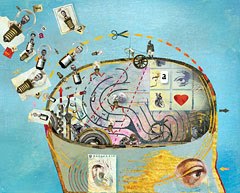
Cognitivist Learning Theory
How does learning occur?
The way that learning occurs under the cognitivist umbrella is based largely on information processing theory. According to Ormrod, et al. (2009), “cognitive information processing theories focus on how people attend to environmental events, encode information to be learned and relate it to new knowledge in memory, store new knowledge in memory, and retrieve it as needed” (p. 48). Learning is structured and transpires through cognitive encoding, rehearsal, storage, and retrieval of schemata. Learning occurs internally, but also through social interactions with others.
What factors influence learning?
Well organized and structured instruction will help generate cognitive learning experiences. Logical relationships between key ideas and concepts should be clearly linked (Smith, 1999). Prior knowledge that can be retrieved from one’s short or long-term memory can also be an influential learning factor. The use of graphic organizers and analogies can help learners tap into prior knowledge in a structured way. Past experience is another factor that influences learning (Davis, et al., 2008). It is through the context of past experience that a learner initially encodes new information. Remembering a specific experience helps a person remember conceptual knowledge related to that experience. Along with personal experience, Ertmer and Newby (1993) note that a learner’s thoughts, beliefs, attitudes, and values can also impact learning outcomes.
What is the role of memory?
The encoding and retrieval of information to and from memory plays a significant role in cognitivist learning theory. It is through information processing (mentioned above) that concepts are encoded and stored into a person’s memory. The two-store (dual-memory) model, as explained by Ormrod, et al. (2009), breaks learning and memory down into simple stages. The process begins with a stimulus input interrupting one or more of the senses. Next, the appropriate sensory register receives the input. It is at this stage that perception occurs and meaning is assigned to the stimulus. From the sensory register, information is then transferred to short-term (working) memory and then to long-term memory (Ormrod, et al., 2009).
How does transfer occur?
The effects of prior learning on new tasks or materials help with the transfer of conceptual or procedural knowledge across tasks. According to Ormrod, et al. (2009) positive transfer takes place when prior learning facilitates learning, while negative transfer occurs when prior learning interferes with new learning. Transfer goes back to information processing theory, which is a key component of cognitivism. When schemata in one’s memory are linked, there is a greater chance that other pieces of information will become activated in the memory. This, in turn, results in transfer of knowledge.
What types of learning are best explained by cognitivist theory?
While more complex learning tasks such as problem-solving and reasoning are explained best by behaviorist theory, lower-level learning tasks such as memorizing, recognizing, and labeling require a cognitivst approach (Kapp, 2007). Some examples of cognitive learning tasks would be predicting meaning, completing fields in a matrix, and using mnemonic devices.
How is technology used for learning in the teaching field?
Technology can be a fantastic educational resource for cognitivist learning activities. For example, a cognitive learning task such as creating a graphic organizer can now be done through computer and web-based programs including Webspiration, Spinscape, and FreeMind, to name a few. Also, websites such as ReadWriteThink.org provide opportunities for students to complete cognitive learning tasks online through the use of interactive note-taking and outlining tools. Click on the following link for more interactive cognitive learning activities: Read-Write- Think Activities.